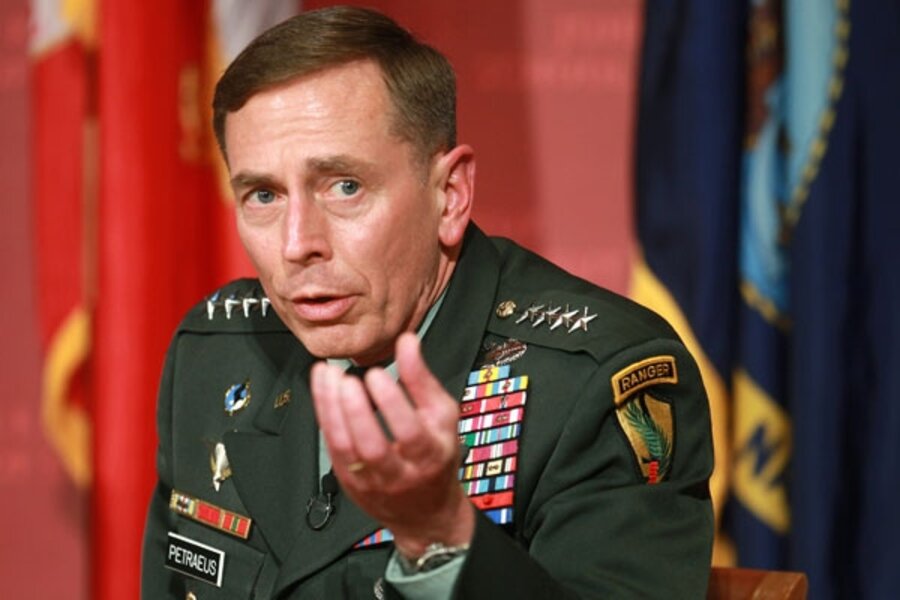Petraeus: What I learned in Iraq, and how it applies to Afghanistan
Loading...
CAMBRIDGE, MASS. – As the US shifts focus from Iraq to Afghanistan, much attention has been given to how counterinsurgency strategies honed against Al Qaeda in Iraq may be applied to a resurgent Taliban.
If one man has the answer, it just might be Gen. David Petraeus.
Credited with turning around a war in Iraq that many considered hopeless, the four-star general has since become CENTCOM commander – putting Afghanistan, Pakistan, and Iran under his aegis as well. In a speech Tuesday at Harvard University, he laid out the elements that helped reduce violence in Iraq to its lowest levels since 2003. Many aspects of those counterinsurgency efforts, he said, can be successfully applied in Afghanistan – if they are applied in “culturally appropriate” ways.
"We don't move into a village in Afghanistan the way that we were able to move into neighborhoods in Iraq. You have to move on the edge of it – or just near it – but you have to have a persistent security presence," said General Petraeus, who emphasized the need for fierce persistence. “When you get teeth into the enemy, you can’t let go.”
That leadership has inspired not a few, including Harvard graduate student Seth Moulton, who introduced the general. After serving three tours in Iraq, Mr. Moulton petitioned to go back for a fourth when he heard that Petraeus was named as top commander. Petraeus was visiting the school to honor Moulton and other students who served in the military.
'Be first with the truth - even on bad days'
A man who wrote his doctoral dissertation on the US military and lessons learned in Vietnam, Petraeus is intimately familiar with the dangers of quagmire-like conflicts. (Read his dissertation here.)
But he said he was convinced that the surge could work in Iraq – and most agree it has.
Initially, the outlook was bleak, and he was the first to admit it. Part of his communications strategy in Iraq, Petraeus said, was to “be first with the truth – even on bad days.” When very senior officials started telling him he had a messaging problem – implying that he should project a more positive image of the campaign – he would tell them, “Sir, we don’t have a messaging problem, we have a results problem.”
Joking that a military man can never be without his slides and laser pointer, Petraeus projected onto a screen the odds he faced in getting results from the surge, launched in early 2007. (To see the chart, download this .pdf and click on page 2.)
As US efforts intensified, so did the violence – peaking less than two months before Petraeus was to give his September testimony to Congress.
It then dropped – precipitously. By October, Iraq was quieter than it had been in almost three years.
How he did it
At Fort Leavenworth in Kansas – the Army’s “Harvard,” Petraeus called it – much work was done evaluating and refining strategies being used in Iraq. One outcome was the development of a counterinsurgency manual that Petraeus oversaw.
An example of the thoroughness and specificity of the military’s approach is the Anaconda strategy. It identified seven things Al Qaeda in Iraq (AQI) needed – money, command and control, ideology, popular support, safe havens, weapons, foreign fighters – and developed specific ways to prevent AQI from getting each one. (Click here for the chart, found on page 9 of the .pdf mentioned above.)
Now, for Afghanistan
He didn't lay out as comprehensive a strategy for Afghanistan, but he's a big champion of having one - a lesson he drew from Ulysses S. Grant. (During the worst days in Iraq, he would seek haven in a few pages of the Pulitzer Prize-winning tome "Grant Takes Command," before falling asleep with the light on.)
The two wars are very different, Petraeus made sure to emphasize, although some lessons from Iraq may carry over.
For starters, he says, “you can’t kill or capture your way out of an industrial-strength insurgency…. There must be reconciliation.”
But exactly which Taliban members would be willing to negotiate, and which are too hard-core? We don’t know, Petraeus said.
Part of the problem is that the US lacks the “rigorous, granular, nuanced” intelligence it needs on the South Asian country.
“It’s gonna get worse before it gets better,” and the US may not see the “dramatic downturn” of violence that it did in Iraq, he said.
Then again, Petraeus's idea of PR is to “underpromise and overdeliver.”
To see a video of Petraeus's speech, click here.





